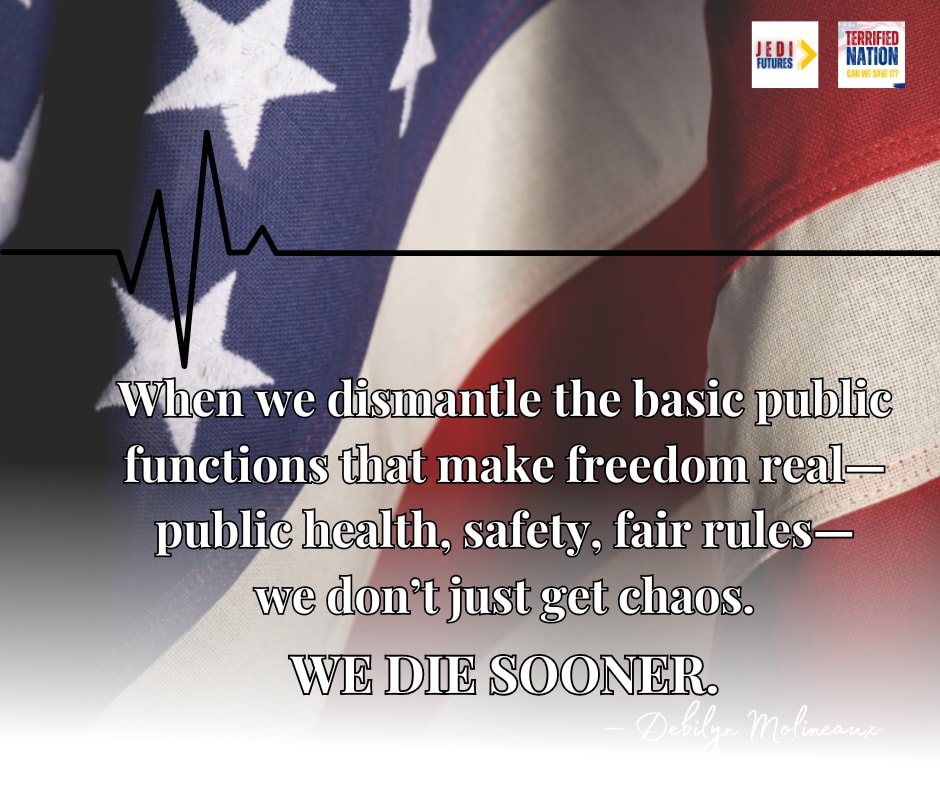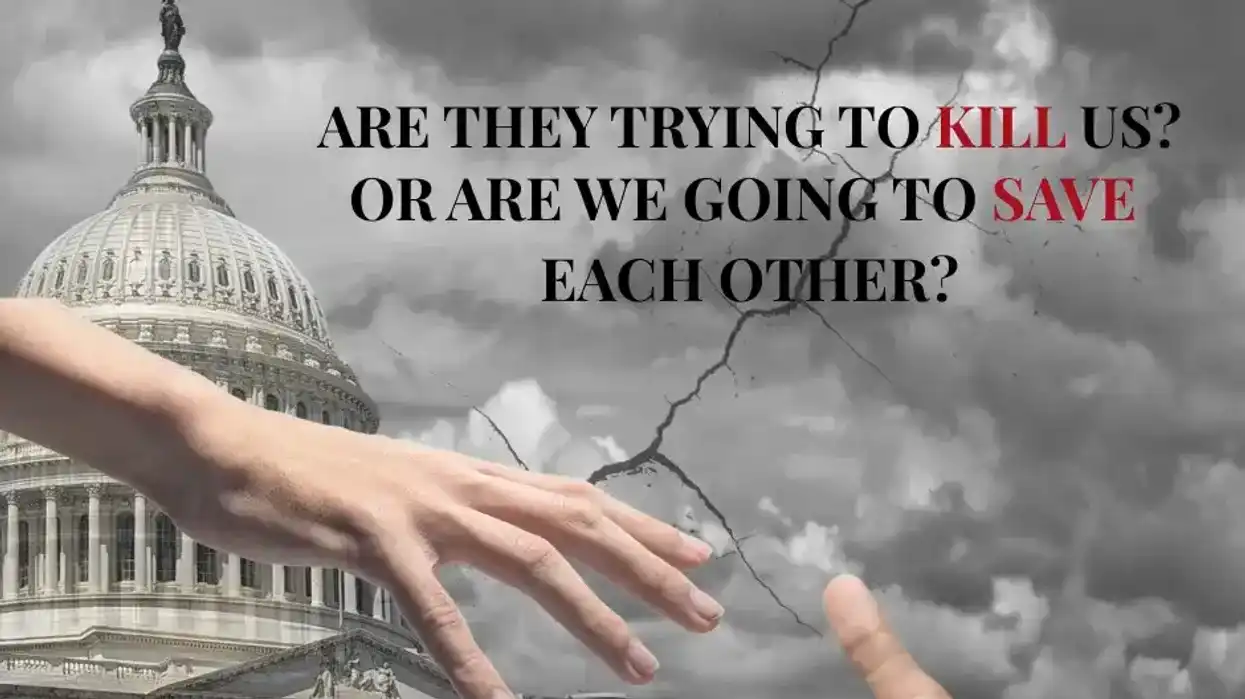In the rush to “dismantle the administrative state,” some insist that freeing people from “burdensome bureaucracy” will unleash thriving. Will it? Let’s look together.
A century ago, bureaucracy was minimal. The 1920s followed a worldwide pandemic that killed an estimated 17.4–50 million people. While the virus spread, the Great War raged; we can still picture the dehumanizing use of mustard gas and trench warfare. When the war ended, the Roaring Twenties erupted as an antidote to grief. Despite Prohibition, life was a party—until the crash of 1929. The 1930s opened with a global depression, record joblessness, homelessness, and hunger. Despair spread faster than the pandemic had.
This was the context when Franklin Delano Roosevelt took office in 1933. The nation was demoralized by nonresponsiveness, corruption, and rot. Over the next decade, FDR passed a series of policies that made up the New Deal for American workers. He reset our measure of success from “take what you can hold” to “a chicken in every pot.” Large public projects put people to work. Pride in earning a living, providing for families, and building together helped heal. These common efforts—Hoover Dam, CCC reforestation, rural electrification—are reminders of what’s possible. They still belong to us, the people. FDR fought with industrialists and their politicians to level the playing field for working Americans.
Before FDR, Presidents Warren G. Harding (1921–23) and Calvin Coolidge (1923–29) championed a “small government, pro-business” creed—lower taxes and regulations, high tariffs, and a hands-off posture toward corporate power. Their era also carried the stain of major scandals like Teapot Dome. With that context, today’s moves—tariffs, shrinking federal capacity, pressuring the Fed, and a fog of favoritism—feel like a remix of the 1920s playbook. So what do we do about this?
The 1920s → 2020s: the rhyme we can’t ignore
A century ago, America flirted with minimal federal guardrails just as new risks were exploding. The decade glittered—right up to the cliff’s edge. Today, we’re repeating patterns that predict more suffering and earlier deaths, especially for kids, elders, and low-income families.
- Public health pullback. The 1920s briefly invested in maternal and infant health (Sheppard–Towner) and then let it die in 1929—exactly when families needed it. Today, cuts or rollbacks to public-health capacity (disease surveillance, vaccination programs, mental-health lifelines) send the same message: you’re on your own. We know how that story ends—avoidable deaths that land heaviest on those with the fewest resources.
- Environmental non-protection. In the 1920s, national air and water protections didn’t exist. Industrial growth came with a hidden casket count: heart and lung disease from soot, chemical exposures, poisoned rivers. Now, attempts to weaken pollution standards, methane controls, conservation rules, and climate resilience push us back toward that pre-regulatory baseline—just as heat waves and wildfire smoke intensify.
- Labor and child safety were viewed as “cost centers.” Before modern labor law, workplaces were more lethal and kids worked dangerous jobs. Loosening enforcement today or expanding hazardous youth work echoes those risks—and robs children of schooling that lengthens lifetime health and earnings.
- Breadlines without safety nets. The 1920s offered little protection when incomes collapsed. Today, proposals to shrink SNAP, Medicaid, and IRS capacity (which delivers the EITC and Child Tax Credit) weaken the very programs proven to improve birth outcomes, reduce medical debt, and stabilize families.
- Moral panics, real violence. Then, Prohibition and nativist politics. Now, defunding community violence-intervention and loosening restrictions to carry weapons even as political temperature spikes. Then as now: when prevention capacity is stripped, the funeral homes get busier.
The throughline is simple: when we dismantle the basic public functions that make freedom real—health, safety, fair rules—life expectancy falls. There’s nothing “pro-life” about that.
 What breaks the cycle: a practical bargain for longer, better lives
What breaks the cycle: a practical bargain for longer, better lives
The good news is we’ve learned a lot since the 1920s. We know which policies lengthen lives and expand opportunity at the same time. The Grand Bargain Project (GBP) doesn’t sell a silver bullet; it offers a package that stacks life-extending, prosperity-building reforms across six areas. Here’s how that package counters today’s risks:
Greater economic opportunity & growth.
Health is a growth strategy. Expanding the Earned Income Tax Credit and childcare access, investing in rural and low-income urban entrepreneurship, and cutting red tape for affordable housing all boost labor participation and family stability—while reducing the conditions that drive early death. Community-college upskilling tied to fast-growing sectors turns dead-end jobs into ladders.
Schools that enable kids to reach their potential.
Title I support, school meals, broadband, and evidence-based teacher development improve achievement now and adult health later. Accountability paired with resources—not austerity—closes gaps. Kids who learn and eat well today become adults who live longer tomorrow.
Effective & affordable healthcare.
Pay for outcomes, not volume. Expand community health support in rural and distressed places. Protect reproductive care and maternal health. Strengthen Accountable Care Organizations and negotiate drug prices. These are cost-cutting, life-saving levers that avoid the false choice between health and budgets.
Spending efficiently to lower the national debt.
Prevention is cheaper than the ICU. Clean air, violence interruption, nutrition, and early care reduce downstream costs. Modernizing revenue collection (yes, a capable IRS) ensures everyone pays what they owe so we don’t starve the very programs that save lives and money.
Dependable, clean & affordable energy.
A predictable carbon price with rebates for low-income and rural families, plus streamlined transmission, accelerates cleaner air and lowers bills. Pair it with methane abatement and conservation and you get fewer asthma attacks, heart crises, and heat-related deaths—measurable gains in life expectancy.
A fairer, simpler tax code.
Simplify. Broaden the base. Cut the carve-outs that reward tax gymnastics over real productivity. Align business incentives with investment and wages. Protect pro-health credits like the EITC with reliable administration. That’s how we fund the basics without sandbagging growth.
“Are they trying to kill us?” Or are we going to save each other?
If you look only at the headlines—cuts to the very systems that keep people alive—it’s easy to conclude that yes, some leaders are comfortable with sicker, shorter-lived Americans as long as their faction is satisfied. But we are not condemned to replay the 1920s. The New Deal wasn’t magic; it was mobilization. People demanded a better deal and then showed up—on job sites, in union halls, at ballot boxes.
The Grand Bargain approach is how we show up now. It’s not a culture-war victory lap. It’s a coalition of neighbors who want to live longer, spend less on preventable tragedy, and hand our kids a future that’s cleaner, saner, and fairer. People from left, right, and center are choosing a package they prefer to the status quo, even when it includes trade-offs. That’s how big changes happen: together, with enough trust to trade.
A century ago, we chose practical solutions over posturing. We can do that again—cleaner air, safer communities, better schools, fairer taxes, and lower debt. But it only happens if enough of us lean in and choose a deal we can live with—and live longer because of.
Yes, They Are Trying To Kill Us was first published on Debilyn Molineaux's substack platform and was republished with permission.
Debilyn Molineaux is a storyteller, collaborator & connector. For 20 years, she led cross-partisan organizations. She currently holds several roles, including catalyst for JEDIFutures.org and podcast host of Terrified Nation. She also works with the Center for Collaborative Democracy, which is home to the Grand Bargain Project as a way to unify Americans by getting unstuck on six big issues, all at the same time. She previously co-founded BridgeAlliance, Living Room Conversations, and the National Week of Conversation. You can learn more about her work on LinkedIn.




















